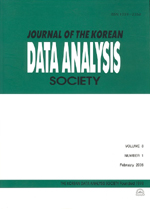웹기반 실험을 통해 살펴본 연령에 따른 긍정정서 편향과 자기연령 효과의 차이
Age-related differences in the positive emotion bias and own-age effect through web-based experiment
- 한국자료분석학회
- Journal of The Korean Data Analysis Society (JKDAS)
- Vol.25 No.3
-
2023.061145 - 1159 (15 pages)
-
DOI : 10.37727/jkdas.2023.25.3.1145
- 44

얼굴 표정으로 전달되는 정서 정보는 사람들의 주의를 끄는데 특히 부정정서는 주의를 강하게 끈다. 하지만 노화에 진행됨에 따라 사람들은 부정 정서보다는 긍정 정서에 빠르게 주의를 기울이게 된다. 본 연구는 서구권의 이러한 연구 결과가 한국인들에게서도 나타나는지를 살펴보기 위하여 20세부터 69세까지의 지역사회 성인들을 대상으로 웹기반 탐침 탐사과제를 실시하고, 이를 통해 연령에 따른 자동적 정서 편향 효과를 차이를 비교하였다. 또한, 본 연구에서는 두 개의 연령 집단(젊은 배우 혹은 나이 든 배우)의 사진을 이용하여 참가자의 연령과 유사한 연령으로 보이는 자극에 주의를 기울이는 자기 연령 효과가 나타나는지를 확인하고자 하였다. 연구 결과, 모든 연령대의 참가자들은 부정 정서보다는 긍정 정서에 주의를 더 기울이는 특성을 보였고, 30대 참가자들의 경우에는 자신과 비슷한 나이대로 보이는 긍정 및 부정 얼굴 표정에 더 주의를 기울였다. 이러한 결과는 한국인의 경우 연령에 관계없이 긍정적인 얼굴 표정에 주의를 기울이며 주의 편향이 자극의 특성에 따라 달라진다는 것을 보여준다.
Emotional information conveyed through facial expressions captures people's attention. While negative emotions closely related to general human survival tend to attract attention, as aging progresses, people tend to shift their attention more quickly to positive emotions than negative ones. This study utilized the dot-probe task to examine whether positive emotion bias varies with age among adults aged 20 to 69. Additionally, this study aimed to investigate whether the own-age effect occurs using photos of two age groups (i.e., a young actor and an elderly actor). The results of the study showed that participants of all age groups tended to focus more on positive emotions. The results also showed the own-age effect such that 30’s age group payed more attention to positive and negative facial expressions of the young actors. These results suggest that positive emotions are recognized as important social information for all age groups, and attention bias differs according to the nature of the stimuli.
1. 서론
2. 연구
5. 종합 논의
References
(0)
(0)